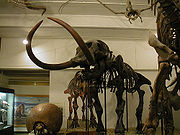
Boaz mastodon
Encyclopedia

Mastodon
Mastodons were large tusked mammal species of the extinct genus Mammut which inhabited Asia, Africa, Europe, North America and Central America from the Oligocene through Pleistocene, 33.9 mya to 11,000 years ago. The American mastodon is the most recent and best known species of the group...
found near Boaz, Wisconsin
Boaz, Wisconsin
Boaz is a village in Richland County, Wisconsin, United States. The population was 137 at the 2000 census.-Geography:Boaz is located at ....
in 1897. A fluted quartzite
Quartzite
Quartzite is a hard metamorphic rock which was originally sandstone. Sandstone is converted into quartzite through heating and pressure usually related to tectonic compression within orogenic belts. Pure quartzite is usually white to gray, though quartzites often occur in various shades of pink...
spear point found near the Boaz mastodon suggests that humans hunted mastodons in southwestern Wisconsin
Wisconsin
Wisconsin is a U.S. state located in the north-central United States and is part of the Midwest. It is bordered by Minnesota to the west, Iowa to the southwest, Illinois to the south, Lake Michigan to the east, Michigan to the northeast, and Lake Superior to the north. Wisconsin's capital is...
.
History
Following a heavy rainfall on July 10, 1897, the sons (Harry, Chris, Verne, Clyde) of farmer John Dosch were checking for flood damage along the eastern branch of Mill Creek near the village of Boaz when they discovered some unusual bones sticking out of the creek bank where it had been partially washed away. The boys excavated the bones and displayed them by a hitching post near the road. The local mailman spread the word about the find and the following week stories about it appeared in the Republican Observer, the Richland Democrat, and the Viola Observer. What was described as an arrowhead was found in clay near a rib. The bones were moved to the basement of the Dosch farmhouse. Later, Frank Burnham, a Richland Center, WisconsinRichland Center, Wisconsin
Richland Center is a city in Richland County, Wisconsin, United States, which also serves as the county seat. The population was 5,184 at the 2010 census.-History:Richland Center was founded in 1851 by Ira Sherwin Hazeltine, a native of Andover, Vermont...
, attorney and member of the state legislature, negotiated the sale of the bones to the State of Wisconsin for fifty dollars. The skeleton, which is about two-thirds complete and missing its tusks, was reconstructed in 1915 by M. G. Mehl and G. M. Schwartz and is housed in the Geology Museum of the University of Wisconsin
UW-Madison Geology Museum
The UW–Madison Geology Museum is a geology and paleontology museum housed in Weeks Hall, in the southwest part of the University of Wisconsin–Madison campus. The museum's main undertakings are exhibits, outreach to the public, and research. It has the second highest attendance of any museum at the...
. It is estimated that the Boaz mastodon was eighteen feet long, stood nine and a quarter feet high, and weighed six to eight tons.
The arrowhead did not accompany the bones when they were sent to the University of Wisconsin. In the 1940s the University of Wisconsin received an envelope containing a quartzite spear point. The return address on the envelope was D. C. L. Dosch, Maysville, Missouri
Maysville, Missouri
Maysville is a city in DeKalb County, Missouri, United States. The population was 1,212 at the 2000 census. It is the county seat of DeKalb County.Maysville is part of the St. Joseph, MO–KS Metropolitan Statistical Area.-Geography:...
; and scribbled on the envelope was "allegidly found with U.W. elephant." In 1962 the two surviving Dosch brothers identified the point as like the one they had found 66 years previously. The fluted spear point is made of quartzite from the Silver Mound Archeological District
Silver Mound Archeological District
Silver Mound is a sandstone hill in Wisconsin where American Indians quarried quartzite for stone tools. Tools made from Silver Mound's quartzite have been found as far away as Kentucky. The oldest have been dated to around 11,000 years ago, so they provide clues about the first people in Wisconsin...
which is about 80 miles north of Boaz.

